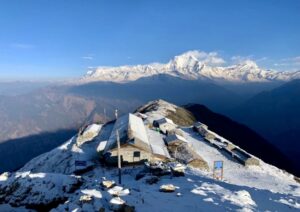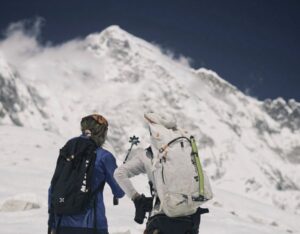At 8,188m, Cho Oyu is the sixth-highest mountain in the world. It lies 20km west of Mount Everest and sits astride the border of Tibet and Nepal. Therein lies much of its recent intrigue. China has closed the easier Tibetan side of the mountain to foreign climbers since COVID.
As a small group of climbers prepare to attempt Cho Oyu from the Nepal side, we review the climbing history of the Turquoise Goddess.
By the numbers
Cho Oyu was the fifth 8,000m peak to be climbed. Austrians Sepp Joechler, Herbert Tichy, and Nepali Pasang Dawa Sherpa made its first ascent on October 19, 1954, without O2, via the West Ridge-West Face. From that time until its last ascent on September 30, 2020, a total of 3,923 people have climbed Cho Oyu. More than 60% of them (2,391 climbers) did so without bottled oxygen.

Cho Oyu. Photo: Guias Benasque
Female ascents
A total of 324 women have climbed Cho Oyu, including 135 without supplementary oxygen.
The first women summiters were Czechs Vera Komarkova and Margita Sterbova. They used bottled oxygen. The first woman to succeed without supplementary O2 was 26-year-old Veronique Perillat of France, on September 12, 1988.

Dina Sterbova at Cho Oyu. Photo: Archive of Dina Sterbova
Winter ascents
Fourteen mountaineers have climbed Cho Oyu in winter. None used bottled oxygen, and they all climbed independently, without Sherpa support. The 14 includes one woman, Marianne Chapuisat of Switzerland, who summited on February 10, 1992.
Unsurprisingly, the first winter summiters were members of a Polish team. Maciej Pawlikowski and the legendary Maciej Berbeka topped out on February 12, 1985. Three days later, two other Polish team members, Zyga Heinrich and Jerzy Kukuczka, also succeeded.

Maciej Pawlikowski and Maciej Berbeka on Cho Oyu. Photo: Andrzej Zawada
It’s been a long time since Cho Oyu was last climbed in winter. Juanjo Garra and Jordi Magrina Guell of Spain were the last to reach the summit during calendar winter, on January 26, 1994. In that joint Swiss-Spanish expedition, two Swiss climbers died. Garra frostbit his fingers, Magrina fell 20m, and both frostnipped their toes. But they summited and safely descended.
The Himalayan Database shows 18 winter summiters in all, although four of these came before the winter solstice: Czechs Dusan Becik and Jaryk Stejskal summited on December 5, 1985; and Spaniards Jon Beloki and Alberto Inurrategui topped out on December 3, 2002.
Thus, a total of 14 climbers summited Cho Oyu during calendar winter.

Fernando Garrido. Photo: Cesar Perez de Tudela
A winter solo
One of the most spectacular solo ascents on an 8,000m peak took place on Cho Oyu in winter. Fernando Garrido of Spain was 29 when he soloed it on February 6, 1988. His climb marked the first winter solo of any 8,000m peak, as well as the first solo ascent of Cho Oyu.
“I don’t like to climb with people,” he said simply.
Three years earlier, in 1985, Garrido set a record for staying alone for the longest time at altitude. He spent 62 days and nights on the top of Aconcagua, at 6,959m.

The normal route on Cho Oyu. Photo: Animal de Ruta
Routes on Cho Oyu
There are 13 routes on Cho Oyu.
The normal route goes up the Northwest Face, which is located on the Tibetan (Chinese) side.
Of all ascents, less than 100 took place on routes other than the normal one.
The south side of the mountain is the Nepalese side. Here, there are already three routes, or even four, if we count the one that leads along the ridge between Nepal and China.
The South Face of Cho Oyu is bounded by the southeast buttress (climbed by the Austrians in 1978) and the southwest buttress (still unclimbed).

The 1985 South Buttress route. Photo: Animal de Ruta
In October 1978, an Austrian party made the first ascent from the Nepalese side, via the right side of the South Face (Southeast Face).
Then in 1985, during the first successful winter ascent, the Polish team went up the south buttress, along the border between Nepal and China.
In the autumn of 1991, a Russian party climbed Cho Oyu by the extremely difficult and long southeast ridge-east ridge route. One of the team members died along the way.
Urubko’s climb
Finally, in the spring of 2009, Denis Urubko wanted to complete his 14×8,000’ers, and only Cho Oyu remained. However, China had closed the mountain to foreign climbers at that time. Urubko and partner Boris Dedeshko climbed Cho Oyu from the Nepalese side, via the Southeast Face. Their route connected at about 8,000m with the 1985 Polish route.
The stoic message that Urubko sent after the climb perfectly describes the difficulty of their route.
“All OK. We are at Base Camp. Healthy in general. The line above 7,600m did not change our plans much. We spent the night at 6,000m, just sitting. There was bad weather on the third day, lots of avalanches, then a storm starting at 7,600m that lasted 15 hours. Afterward, the descent via the ascent route took three days. We haven’t eaten for two days.”

Boris Dedeshko and Denis Urubko’s new 2009 route on the Nepali side of Cho Oyu. Photo: Animal de Ruta






